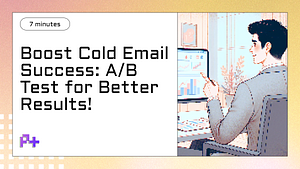Summary
- 1. What is A/B Testing in Cold Emailing and Why is It Important?
- 2. Key Elements to A/B Test in Your Cold Emails
- 3. Strategies to Improve Open Rates, Response Rates, and Click-Through Rates
- 4. Best Practices for Running Effective A/B Tests in Cold Email Campaigns
- 5. Analyzing Results: How to Implement Findings for Better Cold Email Performance
1. What is A/B Testing in Cold Emailing and Why is It Important?
A/B testing, also known as split testing, is a method used to compare two versions of an email to determine which one performs better. In the context of cold emailing, this technique involves sending two variations of an email—often differing in subject line, body content, or call-to-action—to separate segments of your audience. By analyzing the responses from each group, marketers can identify which email elicited a higher open rate, click-through rate, or conversion rate. This data-driven approach allows businesses to refine their messaging and optimize future campaigns, leading to improved engagement and better results.
The importance of A/B testing in cold emailing cannot be overstated. Cold emails are often sent to prospects who may not yet be familiar with your brand, making it crucial to capture their attention quickly. A/B testing helps in understanding what resonates with your target audience, enabling you to craft emails that are not only more appealing but also more effective at achieving your goals. For example, a simple change in the subject line can significantly impact open rates, while variations in the email’s content can influence engagement levels. By systematically testing these elements, you can make informed decisions that enhance your overall outreach strategy.
Moreover, A/B testing in cold emailing leads to continuous improvement and learning. Each test provides insights that contribute to a deeper understanding of your audience's preferences and behaviors. With every iteration, you can refine your messaging, tailor your approach, and ultimately increase the likelihood of converting cold leads into customers. This iterative process not only boosts your email campaign’s performance but also empowers your marketing strategy as a whole. By leveraging A/B testing, businesses can achieve better results in their cold emailing efforts, transforming initial outreach into meaningful connections with potential clients.
2. Key Elements to A/B Test in Your Cold Emails
When it comes to A/B testing cold emails for better results, focusing on key elements can significantly enhance your outreach efforts. One of the most crucial aspects to consider is the subject line. This is the first impression your recipient has of your email and can determine whether they open it or send it straight to the trash. Experimenting with different wording, lengths, and styles can yield insights into what resonates with your audience. For example, testing a straightforward subject line against a more personalized or intriguing one can help you identify which approach leads to higher open rates. Remember to keep your subject lines relevant to the email content and aligned with your brand voice to maintain consistency.
Next, the body content of your cold emails plays a vital role in your A/B testing strategy. This includes not only the message itself but also the overall structure and formatting. Consider experimenting with varying lengths of email text, using bullet points for readability, and including calls-to-action (CTAs) in different positions within the email. For instance, you might test a shorter, concise version against a more detailed one to see which captures your audience's attention more effectively. Additionally, incorporating personalization elements, such as the recipient’s name or specific references to their business, can drastically improve engagement rates. Tailoring your message to address the recipient’s pain points or interests enhances the likelihood of a favorable response.
Finally, the timing and frequency of your cold emails can also be pivotal in achieving better results through A/B testing. Analyze different sending times—such as mornings versus afternoons during weekdays—and adjust your strategy accordingly. You might find that certain times yield higher open rates or responses. Moreover, testing the frequency of your outreach, whether to space emails a few days apart or to follow up more aggressively, can help you discover the optimal balance that maintains engagement without overwhelming your prospects. By meticulously examining these elements in your A/B tests, you can refine your cold email strategy to significantly improve your overall effectiveness and response rates.
3. Strategies to Improve Open Rates, Response Rates, and Click-Through Rates
To enhance the effectiveness of your cold email campaigns, implementing strategic A/B testing can significantly improve open rates, response rates, and click-through rates. One of the most effective strategies is to experiment with subject lines. The subject line is the first thing your recipients see, making it a critical factor in whether they choose to open your email. Consider A/B testing different styles, such as questions versus statements, or incorporating personalization by adding the recipient’s name. Research shows that personalized subject lines can increase open rates by over 26%, making this a powerful tactic in your A/B test of cold emails for better results.
Another strategy to consider is varying the email content itself. Try A/B testing different formats, such as plain text versus HTML emails, or tweaking the length and tone of your message. Shorter, more concise emails often yield higher response rates, especially among busy professionals. Incorporating a clear call-to-action (CTA) is also crucial; test different placements and wording of your CTAs to see which prompts the most engagement. For instance, a direct, action-oriented CTA may lead to higher click-through rates compared to a more passive approach. By analyzing the results of these tests, you can refine your email strategy to align with what resonates most with your audience.
Lastly, timing plays a significant role in the success of cold emails. A/B test your sending times to determine when your target audience is most likely to engage with your emails. Studies indicate that emails sent on Tuesdays and Thursdays often see higher open and response rates. Additionally, consider testing different times of day, as sending emails during lunch breaks or early mornings can catch recipients when they are more likely to check their inbox. By combining these strategies and continually analyzing your results, you can optimize your cold email campaigns to achieve better results and drive meaningful engagement with your audience.
4. Best Practices for Running Effective A/B Tests in Cold Email Campaigns
When it comes to optimizing your cold email campaigns, A/B testing is an invaluable strategy that can lead to better results. To run effective A/B tests, it's essential to clearly define your goals. Start by identifying what specific outcomes you want to measure, such as open rates, click-through rates, or response rates. By having a clear objective, you can tailor your tests to focus on the elements that matter most. For instance, if your goal is to increase open rates, you may want to test different subject lines or sending times. Setting measurable goals not only streamlines your testing process but also helps you analyze which variations performed best.
Another best practice for A/B testing in cold email campaigns is to test one variable at a time. This approach ensures that any improvements in your results can be directly attributed to the changes you made. For example, if you alter both the email's content and the call-to-action in the same test, you won’t know which factor led to the change in performance. By isolating variables, you can fine-tune your emails based on solid data. Additionally, ensure that your sample size is large enough to draw reliable conclusions. A small pool of recipients may lead to skewed results that do not accurately reflect the performance of your emails.
Finally, analyze your results comprehensively and apply your insights to future campaigns. After running your A/B tests, take the time to review the data carefully. Look for patterns and trends that can inform your overall email strategy. Consider not only the winning variant but also why it performed better—was it the tone, the timing, or perhaps the offer? Use these insights to refine your future cold email strategies, ensuring that you continuously improve your outreach efforts. Implementing these best practices will not only enhance your A/B testing skills but also significantly contribute to achieving better results in your cold email campaigns.
5. Analyzing Results: How to Implement Findings for Better Cold Email Performance
Analyzing the results of your A/B tests on cold emails is crucial for optimizing your outreach strategy. Once you’ve collected data from your experiments, the first step is to identify which elements of your emails performed best. Look beyond just open rates; consider metrics such as click-through rates, response rates, and conversion rates. By comparing these metrics across different versions of your emails, you can pinpoint which subject lines, content types, or call-to-action placements resonate most with your audience. This comprehensive analysis will provide insights that are essential for crafting more effective cold emails in future campaigns.
Once you’ve determined the winning elements from your A/B tests, it’s time to implement your findings. Start by integrating the successful components into your standard email templates. For instance, if a specific subject line yielded significantly higher open rates, adopt that style across your future emails. Similarly, if a certain layout or tone resulted in better engagement, make it a staple in your cold email strategy. However, remember that continuous improvement is key; the landscape of email marketing evolves, and so do audience preferences. Regularly revisiting and refreshing your email templates with new insights will ensure your outreach remains effective and relevant.
Finally, it’s essential to monitor the performance of your updated cold email campaigns after implementing your findings. Track how the changes impact your metrics over time to ensure that the adjustments lead to sustained improvements. Consider using A/B testing as an ongoing practice rather than a one-time event. By continually experimenting with different elements—such as personalization techniques, email length, or even sending times—you can refine your approach and ultimately achieve better results from your cold emails. This iterative process of testing, analyzing, and implementing will not only enhance your email performance but also foster a deeper understanding of your target audience’s needs and preferences.



